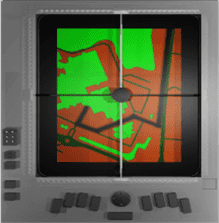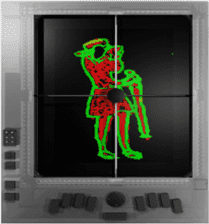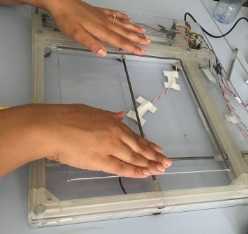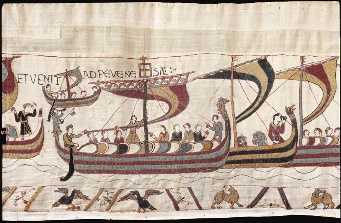Museal Guide
Discovering the Bayeux Tapestry Museum
"MUSEAL GUIDE" project supported by the Normandy Region (France) - 2019-2022
Objective of the project
The “Museal guide” project aims to design, produce and validate the academic prototype of a digital device allowing access both to the museum space (independent mobility) and to the works displayed there (informative and aesthetic accessibility ) in an inclusive approach (for sighted people and people with visual impairment, PPIV). The Bayeux Tapestry Museum and its embroidery (Figure 1) constitute an ecosystem to carry out the experimental work.

Context
Access to works of art in museums is limited not only for PPIV, and more generally people with disabilities, but for everyone (seniors and children included). Today's museums mainly offer portable audio guides, which allow - from the number attached to the work (or an RFID) - to hear a prerecorded text which contains at best only a brief description of the work. In addition, the view is requested both to identify the works and to allow the visitor to understand them. Also, these guides, intended for people with correct sight, are often barriers preventing other visitors from appropriating them. The 2005 law on disability gave rise to a multiplication of tactile workshops organized by museums, but these workshops are above all an introduction to the perception of the materials used by artists (textures) and to the often simplified representations of certain sculptures. PPIV sequentially explores a complex object and tries to integrate a set of disparate elements into a unified mental representation of an object: it takes time, energy, concentration, as well as the feeling of being in confidence and security. Often, many things take on "meaning" only with the intervention of someone who sees and describes them.
No support exists to represent any work of art with an editable display. In addition, the standard indices making it possible to understand and quickly recognize a 2D object represented only in a tactile manner, are very difficult (if not impossible) to represent on conventional non-modifiable supports, because it is not possible to change nor the representation of the work or its scale.
Approach adopted: Museum Guide or portable multimodal digital system.
The guide (Figure 2) is a classic screen tablet on which a specific frame (with different functional buttons) and a mobile micro-joystick have been attached. On the screen a map or the image of a work of art can be displayed. A pair of glasses with a camera (for the acquisition of images of works of art) completes the guide. The guide has different operating modes (each can be activated by a button on the frame):
- programming (route planning),
- map (to understand the overall organization of the space),
- navigation (travel assistance - to reach a room / a work of art / a place - similar to a GPS),
- image (tactile display of the work of art with possibility of modifications), etc. The frame is the interface that will allow you to perceive, by exploring (freely or guided) with a finger placed on your joystick, a simplified, but interactive tactile representation of the information displayed on the screen. This performance will be accompanied by an ad hoc audio description.
In addition, a set of 3D models of certain scenes from the Bayeux Tapestry will be produced (reconstruction using original approaches) with 3D printing to assist in learning the process of understanding the work of art.
Originalities: accessibility to the museum space and aesthetic accessibility.
The Museum Guide therefore offers access to the museum space, and in particular assistance with navigation in this space, like a GPS, but with the difference that it works inside (what the GPS does not) and outside. Figure 3 shows the target display on the Guide to the tactile plan of a museum level with its 4 rooms, and the path (in black) which will allow you to reach one of them.
The Museal Guide makes it possible to create new aesthetic experiences, which induce unprecedented sensory stimulations and which call to mind and imagination, and to share them with others. Indeed, it is possible to make the dynamic elements perceptible to the eye in the work of art be felt tactually (for example, to appreciate the force of the wind that swells the sails of a boat, or the force of the waves of the sea, see Figure 4). Also, the system allows the creation of new aesthetic impressions in any person, which enhances the aesthetic accessibility to the work of art, and makes it an inclusive museum guide.





